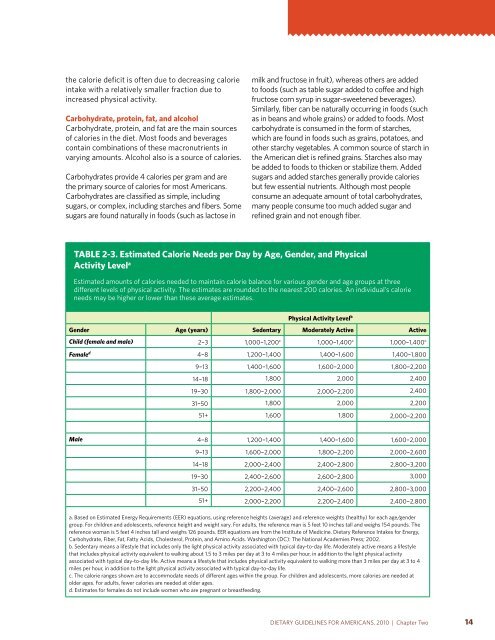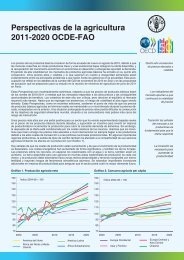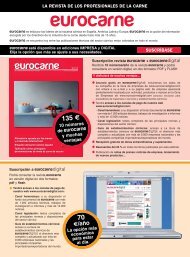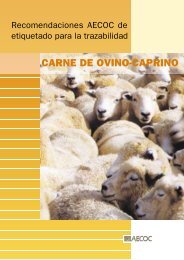Table 2-2 provides the top sources of calories among<strong>Americans</strong> ages 2 years and older. 32 The table revealssome expected differences in intake between younger(ages 2 to 18 years) and adult (ages 19 years andolder) <strong>Americans</strong>. For example, alcoholic beveragesare a major calorie source <strong>for</strong> adults, while fluid milkprovides a greater contribution to calorie intake <strong>for</strong>children and adolescents. Further, while not shownin the table, 33 there is additional variability in caloriesources among children, adolescents, and adults ofdifferent ages. For example, sugar-sweetened beverages34 and pizza are greater calorie contributors <strong>for</strong>those ages 9 to 18 years than <strong>for</strong> younger children.Also, dairy desserts 35 and ready-to-eat cereals providea greater contribution to calorie intake <strong>for</strong> those ages71 years and older than they do among younger adults.Although some of the top calorie sources by categoryare important sources of essential nutrients, othersprovide calories with few essential nutrients. Manyof the foods and beverages most often consumedwithin these top categories are in <strong>for</strong>ms high in solidfats and/or added sugars, thereby contributing excesscalories to the diet. For<strong>for</strong> More in<strong>for</strong>MationSee chapters 3, 4, and 5<strong>for</strong> detailed discussions ofsolid fats and added sugars,additional in<strong>for</strong>mationabout the current dietaryintake of <strong>Americans</strong>, andre<strong>com</strong>mendations <strong>for</strong>improvement.example, many grainbaseddesserts 36 arehigh in added sugars andsolid fats, while manychicken dishes 37 areboth breaded and fried,which adds a substantialnumber of calories tothe chicken.calorie Balance: food andBeverage intakeControlling calorie intake from foods and beveragesis fundamental to achieving and attaining caloriebalance. Understanding calorie needs, knowing foodsources of calories, and recognizing associationsbetween foods and beverages and higher or lowerbody weight are all important concepts when buildingan eating pattern that promotes calorie balanceand weight management. Many <strong>Americans</strong> areunaware of how many calories they need each day orthe calorie content of foods and beverages.understanding calorie needsThe total number of calories a person needs eachday varies depending on a number of factors, includingthe person’s age, gender, height, weight, andlevel of physical activity. In addition, a desire to lose,maintain, or gain weight affects how many caloriesshould be consumed. Table 2-3 provides estimatedtotal calorie needs <strong>for</strong> weight maintenance basedon age, gender, and physical activity level. A moredetailed table is provided in Appendix 6. Estimatesrange from 1,600 to 2,400 calories per day <strong>for</strong> adultwomen and 2,000 to 3,000 calories per day <strong>for</strong> adultmen, depending on age and physical activity level.Within each age and gender category, the low end ofthe range is <strong>for</strong> sedentary individuals; the high end ofthe range is <strong>for</strong> active individuals. Due to reductionsin basal metabolic rate that occurs with aging, calorieneeds generally decrease <strong>for</strong> adults as they age.Estimated needs <strong>for</strong> young children range from 1,000to 2,000 calories per day, and the range <strong>for</strong> olderchildren and adolescents varies substantially from1,400 to 3,200 calories per day, with boys generallyhaving higher calorie needs than girls. These areonly estimates, and estimation of individual calorieneeds can be aided with online tools such as thoseavailable at MyPyramid.gov.Knowing one’s daily calorie needs may be a usefulreference point <strong>for</strong> determining whether the caloriesthat a person eats and drinks are appropriate inrelation to the number of calories needed each day.The best way <strong>for</strong> people to assess whether theyare eating the appropriate number of calories is tomonitor body weight and adjust calorie intake andparticipation in physical activity based on changes inweight over time. A calorie deficit of 500 calories ormore per day is a <strong>com</strong>mon initial goal <strong>for</strong> weight loss<strong>for</strong> adults. However, maintaining a smaller deficitcan have a meaningful influence on body weightover time. The effect of a calorie deficit on weightdoes not depend on how the deficit is produced—byreducing calorie intake, increasing expenditure, orboth. Yet, in research studies, a greater proportion of32. Data are drawn from analyses of usual dietary intakes conducted by the National Cancer Institute. Source: National Cancer Institute. Food sources ofenergy among U.S. population, 2005-2006. Risk Factor Monitoring and Methods. Cancer Control and Population Sciences. 2010. http://riskfactor.cancer.gov/diet/foodsources/. Updated May 21, 2010. Accessed May 21, 2010.33. Additional in<strong>for</strong>mation on the top calorie contributors <strong>for</strong> various age groups, as well as by gender and race/ethnicity, are available at http://riskfactor.cancer.gov/diet/foodsources/.34. Sodas, energy drinks, sports drinks, and sweetened bottled water including vitamin water.35. Includes ice cream, frozen yogurt, sherbet, milk shakes, and pudding.36. Includes cake, cookies, pie, cobbler, sweet rolls, pastries, and donuts.37. Includes fried or baked chicken parts and chicken strips/patties, chicken stir-fries, chicken casseroles, chicken sandwiches, chicken salads, stewedchicken, and other chicken mixed dishes.13DIETARY GUIDELINES FOR AMERICANS, 2010 | Chapter Two
the calorie deficit is often due to decreasing calorieintake with a relatively smaller fraction due toincreased physical activity.carbohydrate, protein, fat, and alcoholCarbohydrate, protein, and fat are the main sourcesof calories in the diet. Most foods and beveragescontain <strong>com</strong>binations of these macronutrients invarying amounts. Alcohol also is a source of calories.Carbohydrates provide 4 calories per gram and arethe primary source of calories <strong>for</strong> most <strong>Americans</strong>.Carbohydrates are classified as simple, includingsugars, or <strong>com</strong>plex, including starches and fibers. Somesugars are found naturally in foods (such as lactose inmilk and fructose in fruit), whereas others are addedto foods (such as table sugar added to coffee and highfructose corn syrup in sugar-sweetened beverages).Similarly, fiber can be naturally occurring in foods (suchas in beans and whole grains) or added to foods. Mostcarbohydrate is consumed in the <strong>for</strong>m of starches,which are found in foods such as grains, potatoes, andother starchy vegetables. A <strong>com</strong>mon source of starch inthe American diet is refined grains. Starches also maybe added to foods to thicken or stabilize them. Addedsugars and added starches generally provide caloriesbut few essential nutrients. Although most peopleconsume an adequate amount of total carbohydrates,many people consume too much added sugar andrefined grain and not enough fiber.taBle 2-3. estimated calorie needs per day by age, gender, and Physicalactivity level aEstimated amounts of calories needed to maintain calorie balance <strong>for</strong> various gender and age groups at threedifferent levels of physical activity. The estimates are rounded to the nearest 200 calories. An individual’s calorieneeds may be higher or lower than these average estimates.Physical activity level bgender age (years) sedentary Moderately active activechild (female and male) 2–3 1,000–1,200 c 1,000–1,400 c 1,000–1,400 cfemale d 4–8 1,200–1,400 1,400–1,600 1,400–1,8009–13 1,400–1,600 1,600–2,000 1,800–2,20014–18 1,800 2,000 2,40019–30 1,800–2,000 2,000–2,200 2,40031–50 1,800 2,000 2,20051+ 1,600 1,800 2,000–2,200male 4–8 1,200–1,400 1,400–1,600 1,600–2,0009–13 1,600–2,000 1,800–2,200 2,000–2,60014–18 2,000–2,400 2,400–2,800 2,800–3,20019–30 2,400–2,600 2,600–2,800 3,00031–50 2,200–2,400 2,400–2,600 2,800–3,00051+ 2,000–2,200 2,200–2,400 2,400–2,800a. Based on Estimated Energy Requirements (EER) equations, using reference heights (average) and reference weights (healthy) <strong>for</strong> each age/gendergroup. For children and adolescents, reference height and weight vary. For adults, the reference man is 5 feet 10 inches tall and weighs 154 pounds. Thereference woman is 5 feet 4 inches tall and weighs 126 pounds. EER equations are from the Institute of Medicine. <strong>Dietary</strong> Reference Intakes <strong>for</strong> Energy,Carbohydrate, Fiber, Fat, Fatty Acids, Cholesterol, Protein, and Amino Acids. Washington (DC): The National Academies Press; 2002.b. Sedentary means a lifestyle that includes only the light physical activity associated with typical day-to-day life. Moderately active means a lifestylethat includes physical activity equivalent to walking about 1.5 to 3 miles per day at 3 to 4 miles per hour, in addition to the light physical activityassociated with typical day-to-day life. Active means a lifestyle that includes physical activity equivalent to walking more than 3 miles per day at 3 to 4miles per hour, in addition to the light physical activity associated with typical day-to-day life.c. The calorie ranges shown are to ac<strong>com</strong>modate needs of different ages within the group. For children and adolescents, more calories are needed atolder ages. For adults, fewer calories are needed at older ages.d. Estimates <strong>for</strong> females do not include women who are pregnant or breastfeeding.DIETARY GUIDELINES FOR AMERICANS, 2010 | Chapter Two 14

















